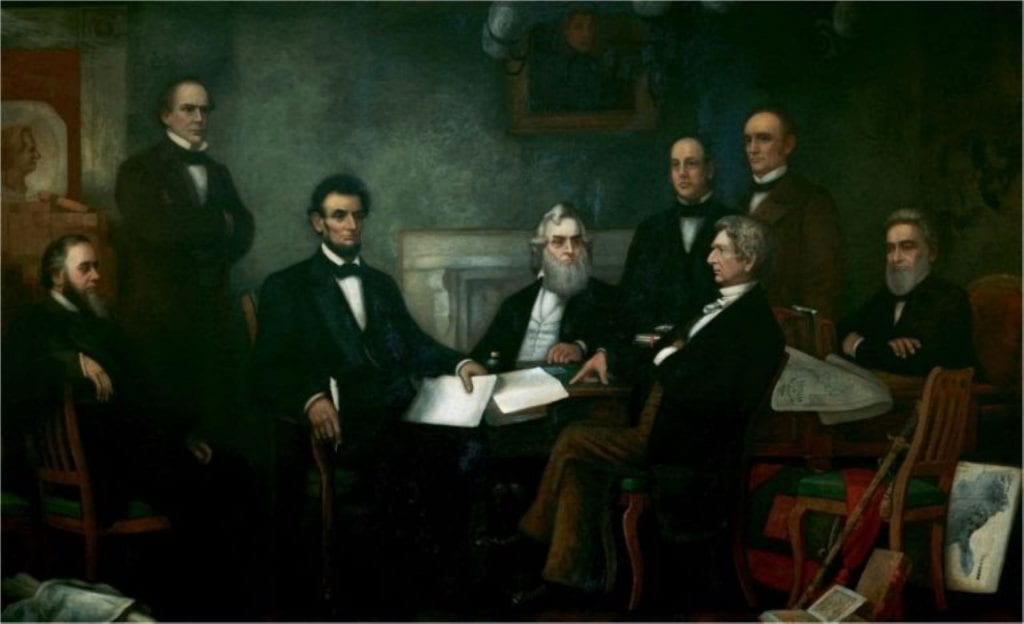Abraham Lincoln’s Emancipation Proclamation of January 1, 1863, declaring the slaves of the rebellious southern states “forever free,” is probably the most important act of his presidency or even his life.
But most people — including a few professional historians — get the Proclamation wrong. Watch out for these 5 big myths about what the Proclamation did, how Lincoln did it, and why.
Myth #1: The Emancipation Proclamation freed no slaves
One popular myth holds that the Emancipation Proclamation actually freed no slaves because it only applied to Confederate-controlled territories. The origins of this myth trace to the time the Proclamation was issued. Lord Lyons, the British minister to the United States during the Civil War, famously quipped that Lincoln had managed to free the slaves in the exact places where he had no political power to do so.
This myth falls apart on two counts. First, the Proclamation encompassed several Union-controlled locations in Virginia and along the east coast. Though estimates are imprecise, the slave populations of these regions likely exceeded 50,000 people, all of whom were legally declared free under the Proclamation the moment it took effect.
As the movement of armies brought more Confederate territory under Union control, the Proclamation’s effective reach extended with it.
Second, the lines of battle changed almost daily for the remainder of the Civil War. As the movement of armies brought more Confederate territory under Union control, the Proclamation’s effective reach extended with it. Lincoln was fully aware of this implication when he crafted the policy, and directed his officers to carry out the Proclamation as the army gained a foothold in the territories it covered.
Myth #2: The Emancipation Proclamation freed all the slaves
The Emancipation Proclamation did not extend to slaves in the border states that remained in the Union after the outbreak of the Civil War (Missouri, Kentucky, Maryland, and Delaware). It also exempted a number of counties in “loyal” regions of the south that were under Union control by 1863. It specifically omitted what was soon to become the state of West Virginia on account of its loyalty to the Union, and it exempted the state of Tennessee, where Andrew Johnson was serving as the unionist military governor.
These exemptions had a variety of political motives including concessions to slave owners in the loyal border states, but they were not purely politicking. They were included primarily for legal reasons.
The Proclamation was a military order, issued under the president’s war powers governing the position of slaves in rebellious regions as authorized by two earlier acts of Congress. Lincoln did not have the authority to free the slaves in the non-rebellious border states or, in some instances, specifically exempted parts of states that had pledged their loyalty.
Lincoln intentionally walked a fine line by declining to apply the Proclamation in these areas, knowing it could antagonize slave owners who were as of yet still loyal to the union. More importantly, Lincoln feared that the Proclamation would be challenged in court as a violation of the Constitution’s implicit recognition of property rights in slaves, or as an overreach of executive authority.
He therefore constructed the Proclamation to apply narrowly to the states and parts of states that were in clear rebellion, hoping this would insulate it from a legal challenge. Though widely anticipated during the last two years of the war, the challenge never came, and the issue was settled in 1865 with the adoption of the Thirteenth Amendment.
Myth #3: “The Surprise Proclamation”
Many popular depictions and even a small number of historians have advanced the notion that Lincoln closely guarded his true intentions with the Emancipation Proclamation until the moment it was signed.
This speculated uncertainty adds a flash of drama to the events of its promulgation, and is sometimes coupled with an anecdote about a group of abolitionists who visited the White House in late December to plead the measure to an indecisive president.
In reality, Lincoln widely broadcast his intentions to issue the Proclamation over the preceding months. He announced its purpose and the January 1st date on September 22, 1862, in what has since become known as the “preliminary” proclamation.
A little over three months later, Lincoln publicly reiterated his intention to issue the measure as scheduled in his written annual message to Congress — the 19th century’s version of a “State of the Union” address. Lincoln wrote specifically, “Nor will the war nor proceedings under the proclamation of September 22, 1862, be stayed” because of a simultaneous plan he was advancing to bring about a peaceful compensated emancipation through more gradual means. He never deviated from this course, and on January 1st he carried out the final Proclamation exactly as planned.
Myth #4: Lincoln viewed the Emancipation Proclamation as the turning point in the fight against slavery
Lincoln no doubt recognized the historical importance of the document he signed on New Year’s Day 1863, but to him it was likely seen as a single step in the multi-year process of fighting the war as well as his own emancipation policy, then well underway. It is important to remember that by the time Lincoln signed the Proclamation, he had actually been pursuing gradual emancipationist measures for over a year.
Lincoln was always cautious in moving against slavery, even taking steps to countermand overly ambitious emancipation orders by his generals during the early stages of the war. But he had already implemented the “contrabands” policy, declaring slaves who reached Union lines to be “contrabands of war,” making them subject to confiscation by the army, and thus free.
In April 1862 he had also signed a law emancipating the slaves of the District of Columbia, compensating their owners in return. When Lincoln signed the Emancipation Proclamation, he likely saw himself as simply moving forward on this same trajectory and doing so as the exigencies of the war dictated.
Witnesses to the surrounding events were actually more inclined to attach significance to the earlier preliminary proclamation of September 22 — at least at the time each happened. The September 22nd document was issued in fulfillment of the “contraband” provisions contained in the two Confiscation Acts passed by Congress earlier that year, but its timing was strategically planned.
Lincoln waited to announce the impending emancipation policy until after the army had secured a victory on the field, so as to bolster its acceptance and deflect claims that he turned to emancipation out of desperation. The Battle of Antietam (on September 17, 1862) was a military draw by most counts, but it effectively stalled Robert E. Lee’s invasion of Maryland. It also gave Lincoln the strategic victory he needed to issue the preliminary proclamation, setting the date of the final proclamation into motion with it.
The September proclamation was a bolder move than that of January 1, and Lincoln’s contemporaries perceived it as such. Artist Francis Bicknell Carpenter actually depicted this document, and not the final version, in his iconic painting of Lincoln reading the Emancipation Proclamation to his cabinet.


The final proclamation of January 1 came to supplant the September 22 date in historical commemoration, perhaps by the end of the war and certainly in the decades that followed. As originally conceived through, it was simply the date of execution for the plan that Lincoln announced to the world a hundred days prior.
Myth #5: The Proclamation marks a turning point in Lincoln’s personal beliefs about slavery
The vast majority of professional historians have resisted the first four myths. But many are guilty of believing in and even advancing #5 — the myth of the Emancipation Proclamation as a conversion moment in Lincoln’s anti-slavery beliefs.
There are two major variants of this myth, so it helps to start with Lincoln’s acknowledged anti-slavery positions prior to 1863. Lincoln was elected to office as an opponent of the expansion of slavery, though not an outright abolitionist. Specifically, Lincoln opposed the expansion of slavery into the western territories as well as the acquisition of new territory for this purpose.
He also followed his political hero Henry Clay in advocating a two-pronged pathway to eventually eliminating slavery from the United States. Clay’s “Whig formula” proposed a program of gradual emancipation extended over many decades in which slave owners would be compensated by the government for their losses. This would also be coupled with the colonization of the freed slaves abroad in a country such as Liberia or, by the time of the Civil War, a closer location in Central America or the Caribbean.
One of the variations of the myth asserts that Lincoln “evolved” beyond this moderate and compromising brand of antislavery in 1863, becoming an “immediatist” abolitionist instead. The second asserts that Lincoln was actually something of a secret abolitionist all along, and only advanced the Whig formula as a ruse or “lullaby” until it was politically possible to obtain a more radical immediatist outcome. In each case, the Emancipation Proclamation is the departure point for Lincoln’s shift.
Dozens of well-regarded historians have even attempted to read esoteric meanings into the Proclamation on account of its silence on compensated emancipation and colonization after both policies appeared in its September 22 precursor.
These arguments ignore several events from the direct context of the Emancipation Proclamation and its wake. At the time he issued the Proclamation, Lincoln was also advancing a compensated emancipation bill in Congress behind the scenes with the help of Sen. John B. Henderson of Missouri, the eventual author of the Thirteenth Amendment. Different versions of Henderson’s bill passed each house of Congress by the end of February 1863, though proslavery forces were able to tie up the reconciliation procedure until the session expired.
Lincoln did not give up on compensation though. He continued to promote the plan as late as February 1865, when he pitched it one last time to his cabinet after making the offer to the Confederates at the failed Hampton Roads peace conference a few days prior.
The evidence is even more stark on colonization. Lincoln actually spent New Years’ Eve in secretive negotiations with a contractor who promised to establish a colony of freed slaves on a Caribbean island leased to him by the government of Haiti. The terms were finalized the morning of January 1st, and the contractor and his Senate backer, James R. Doolittle of Wisconsin, returned to the White House to obtain Lincoln’s signature only a few hours before the Emancipation Proclamation.
Likely aware of these negotiations, Lincoln’s private secretary John Nicolay penned an anonymous newspaper editorial the next day extolling the joint programs of emancipation and colonization as the Lincoln administration’s strike against slavery. As Nicolay put it, the nation would soon see “a successful and prosperous colonization within the tropics of this continent of the black nation today liberated by the President’s wise and just decree.”
In the months after the Proclamation, Lincoln approached the governments of Great Britain and the Netherlands to secure agreements for the colonization of more freed slaves in their respective Caribbean territories. He continued to pursue the policy — albeit unsuccessfully — into at least 1864 when Congress reallocated the colonization budget to the war effort, and he likely considered reviving it shortly before his assassination in 1865.
What we see in both cases, however, is not the shift that many historians have assumed and even attempted to write into Lincoln’s record. Rather, he pursued the course he had laid out in the September 22nd proclamation and expanded upon in his December message to Congress: to carry out military emancipation in the places it could be done under his war powers, while simultaneously pursuing a more permanent end to slavery, albeit by “compromising” means including compensation and colonization, through the political channels.
There is little evidence that he ever deviated from this course and much to attest that he pursued these ends into the post-Proclamation phase of his presidency. So Lincoln seems to have supported concurrently operating policies rather than abandoning his earlier moderation by Lincoln.
So, what did the Emancipation Proclamation actually do?
As we’ve already seen, the provisions of the Emancipation Proclamation were intended to apply to large swaths of land under Confederate control as well as a number of regions in Confederate states that were already within the Union lines though not yet classified as “loyal” by the measure’s text. In doing so, it extended and further codified the Union’s already-existing policy of declaring slaves who reached their lines as “contrabands” of war and freeing them accordingly.
The measure contained two specific expansions upon existing policies. First, it formally authorized the enlistment of African-Americans to the Union war effort. Second, it codified and escalated the Union’s policy of enticement — that is to say, offering the explicit promise of freedom to slaves who escaped their plantations and reached Union territory.
In this latter instance, the Proclamation exploited an inherent fault of the slave system. Slave-based economies require the devotion of vast sums of public resources to prevent escapes and return fugitives — usually in the form of militias, police, and slave patrols. The political economy of the Proclamation therefore sought to increase the Confederacy’s burdens of maintaining this unjust system and did so at a time when its resources were already stretched thin by the raging Civil War.
In short, it attacked slavery at its most vulnerable point — the Confederate government’s ability to preserve the system against the slaves’ own efforts to escape it — by providing an alternative legal and political refuge for escaped as well as directly liberated persons. The Proclamation exploited an inherent fault of the slave system.
While the Proclamation itself was a product of political complexity, motivated by military objectives, its effects were liberating and its success set other more sweeping antislavery measures, including the Thirteenth Amendment, into motion.
To read more about human rights, be sure to check out our cluster page by clicking on the button below.
This article was originally published on the Learn Liberty blog.
This piece solely expresses the opinion of the author and not necessarily the organization as a whole. Students For Liberty is committed to facilitating a broad dialogue for liberty, representing a variety of opinions.

















